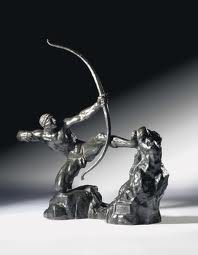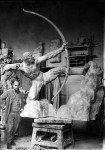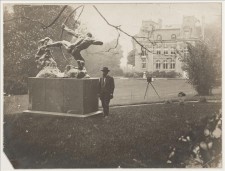

Antoine Bourdelle
French, 1861-1929
Hercules the Archer, 1909
bronze in the lost wax method
32 x 29 in.
SBMA, Bequest of Wright S. Ludington
1993.1.27

Bourdelle in the studio with plaster cast of Hercules the Archer

Bourdelle in the garden with a large bronze of Hercules the Archer
COMMENTS
Trained first in Montauban and then in Toulouse, Bourdelle started work as an assistant in Rodin's studio. The two men were bound together by mutual admiration and respect, even if Bourdelle's desire for synthesis and construction in planes soon opposed him to Rodin's analytical modelling.
From 1905, Bourdelle sought to simplify his lines: "Contain, maintain and master are the rules of construction," he told his pupils over and over again. He looked to mythology for many of his subjects such as Hercules the Archer which enabled him to experiment on a large scale. In his own terms, Apollo was "undertaken in an attempt to master the purest aspect of my deep vision, going far beyond all past flights, I brought to it – more than human blood, bone, cartilage and muscles – the enveloping structure of its forces."
Not only the hero's victory over the monsters, but also Bourdelle's victory over his own high-spirited inspiration, this work is remarkable both for its tension and for its balanced construction. The dynamics come from the interaction of solids and voids, brutal force and balance. The nude figure denotes power, high-strung energy, pulled taut between the arm bending the bow and the foot braced against the rock. The references to primitive Greek sculpture and Roman art – the almond shaped eyes, the nose extending in a straight line from the forehead, jutting cheekbones and brows – act as catalyst for a modern approach.
© Musée d'Orsay, 2006. Representation for any use other than private use is forbidden.
SBMA CURATORIAL LABELS
With this compositional invention, Bourdelle hit upon one of the most enduring images of the early 20th century. Originally conceived as a monumental bronze, depicting one of the Labors of Hercules, and exhibited at the Salon in 1910, the idea was so appealing that Bourdelle authorized multiple versions, which are now on view at museums throughout the world. While the sculptor at first struggled to escape the long shadow cast by Rodin, for whom he worked as a studio assistant, this sculpture displays the greater planarity and archaic source material from which his mature work drew inspiration. The tension and resolve of the archer’s face, echoed by the terrific strain of his muscled body, have become a universal symbol of humanity’s ability to overcome even the most insurmountable of obstacles.
- Rodin and His Legacy, 2017
